Friday, November 17, 2006
Romeo, Juliet & Gladiators
I have no idea what castle this is, but thought it was majestic how it was perched atop the hillside. We passed several castles en route, and it amazed me how many there were, just dotting the landscape.

Verona, also known as Urbis Nobilissima, is the second biggest city (after Venice) in Italy’s Veneto region. We started our visit to Verona with a bus tour. As seems to be the case with many large European cities, there’s a nearby river. You can see that this bridge consists of two different types of bricks. It had been bombed, partially destroyed, then rebuilt, hence the difference. My apologies for the odd shadows--they’re silhouettes from stickers on the bus window.
Many cities also have a town wall, or remnants of one, and Verona is no different. This is one of Verona's city gates.
I thought it was pretty interesting that Verona was built on top of the ruins of Roman city streets. What’s even more amazing is that the current-day streets mirror the streets below the earth, and that both are laid out like well-planned modern-day cities with streets running parallel and perpendicular to each other. This was the only section of the Roman city streets that we saw unearthed.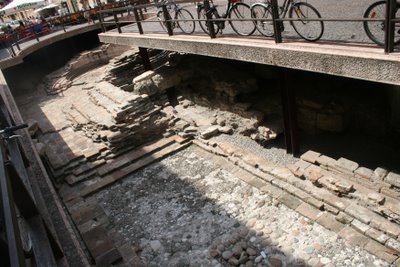
Verona is best-known as the hometown of the most famous lovers in history: Romeo and Juliet. While Shakespeare’s characters are fiction, many scholars believe they are based on real people. Apparently there was a story passed down through the years (many years) about a girl from the Capulet family who had been abducted by the Montague family. The Montague family kept her hostage and eventually she died of starvation. As you can well imagine, a feud began between these two families. Different authors took this story and adapted it from the previous version over the years before it eventually morphed into Shakespeare’s story of “Romeo and Juliet.” While there were no individuals in either of these two families named Romeo or Juliet, the Capulet family has capitalized on Shakespeare’s famous tale of two “star-cross’d lovers” and opened up its family home and courtyard to visitors. Here’s the statue of Juliet. Notice her well-polished body part...apparently it’s good luck to touch her breast when paying a visit (yes, I touched...but didn’t grope).

 Here is the beautiful Capulet family courtyard (left) and the balcony (right) where Juliet is supposed to have been standing when she uttered the famous words, “Romeo, Romeo, wherefore art thou, Romeo?”
Here is the beautiful Capulet family courtyard (left) and the balcony (right) where Juliet is supposed to have been standing when she uttered the famous words, “Romeo, Romeo, wherefore art thou, Romeo?”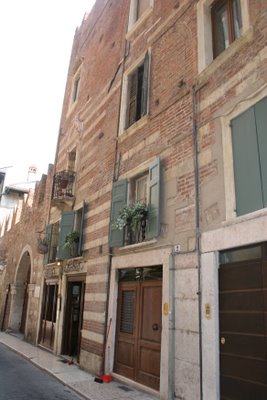
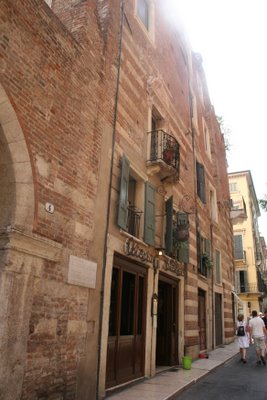
However, the Montague family isn’t as tolerant of tourists as the Capulet family, so I had to take these next two photos of the Montague family home without really stopping. Unfortunately, and much to my dismay, I thought I had written down what these buildings were, but alas, I can’t find any proof that I did. In any case, these buildings are in the heart of the city hall area. I think the top one is where visiting judges would temporarily live. Apparently judges could not be local citizens, but instead would come from other cities and stay for months or years (a set time) so they would be impartial in rendering their judgments. Kinda line current day military TDYs and deployments.
Unfortunately, and much to my dismay, I thought I had written down what these buildings were, but alas, I can’t find any proof that I did. In any case, these buildings are in the heart of the city hall area. I think the top one is where visiting judges would temporarily live. Apparently judges could not be local citizens, but instead would come from other cities and stay for months or years (a set time) so they would be impartial in rendering their judgments. Kinda line current day military TDYs and deployments.
I’m also discovering that people dress in costumes for tips at many major cities throughout Europe. In addition to people dressed in very elaborate Renaissance costumes, we happened upon a very enthusiastic mime.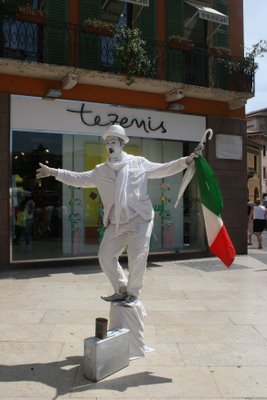
The most famous monument in town is the Roman Amphitheater, commonly known as the Arena. This majestic theater was built in the first century outside the city walls, but in the third century the city walls were extended to envelop the arena within the city itself. It is the second largest, and best preserved, theater of the Roman Empire.
Unfortunately, due to an earthquake in 1117, only part of the original facade remains--the outer ring--which is still visible on the Piazza Bra side (the portion of a wall to the left in this photo).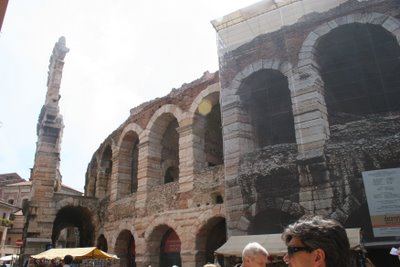
The Arena accommodates more than 22,000 spectators--it is absolutely huge! Here they are prepping the stage for that evening’s performance of Aida. Yes, it is still in use today for operas during the summer season.
This arena is especially well-preserved because the citizens of Verona have always taken good care of it. Already in the 16th century a special commission was designated to restore and preserve it. While it looks majestic and proper today, its original use was for Gladiators' fights. Can’t you just imagine lions entering the Arena from under this arch to fight the gladiators!?!!
I ran into two gladiators outside the Arena. Fortunately, they soon released me (after I tipped them for having my photo made with them).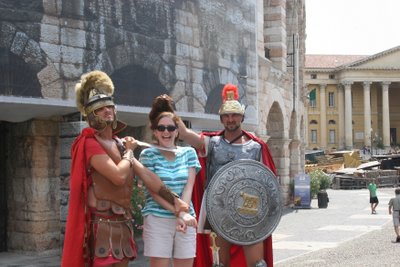
On my first real trip to Italy, I had to take time to enjoy a delicious Italian pizza at an outdoor café within view of the Arena. Fortunately, one of the ladies who joined me for lunch reminded me to ask for “salami pizza” to get the pepperoni I wanted. If I had asked for a “pepperoni pizza,” I would have received a pizza topped with red hot peppers. Lunch wouldn’t have been complete without the serenading of nearby musicians…it was like I had stepped into a movie: eating pizza in the shadow of a Roman amphitheater while being serenaded by Italian musicians. Wow!
